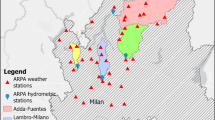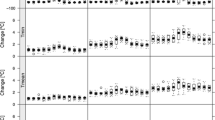Abstract
Trend analysis on observations and model-based climate change simulations are two commonly used methods for climate change detection and impact analysis. Here we propose an integrated assessment and interpretation of climate change impacts as a prerequisite for stakeholder outreach and planning of suitable climate change adaptation measures. The assessment includes (i) identifying trends in meteorological and hydrological observations and their nature, (ii) analysing the relation between the meteorological drivers and generated run-off as an integrated catchment response and (iii) analysing how hitherto changes agree with the simulations by regional climate models (RCMs). The Lusatian river catchments of Spree and Schwarze Elster, characterised by high anthropogenic impact (e.g. mining activities) and low natural water yield, serve as study areas. The results of this study suggest that increases in observed temperature and potential evapotranspiration are robust while observed precipitation remained nearly unchanged (1963–2006). The RCMs agree on simulating a temperature increase but simulate opposing trends for precipitation for both past (1963–2006) and future (2018–2060) periods, the latter inducing differences in the hydrological response (actual evapotranspiration and run-off). For stakeholder outreach, we communicated a range of potential future climates and identified the statistical RCMs (STAR, WettReg) as warm and dry scenarios, and the dynamical RCMs (REMO, CCLM) as wet scenarios. Ultimately, the combined analysis of trends in observations and simulation models can be beneficial for stakeholder outreach and may increase their willingness to plan and implement suitable climate change adaptation strategies which are urgently needed within the Lusatian river catchments.





Similar content being viewed by others
References
Aas C, Ladkin A, Fletcher J (2005) Stakeholder collaboration and heritage management. Ann Tour Res 32:28–48. doi:10.1016/j.annals.2004.04.005
Al-Mukhtar M, Dunger V, Merkel B (2014) Assessing the impacts of climate change on hydrology of the upper reach of the Spree river: Germany. Water Resour Manag 28:2731–2749. doi:10.1007/s11269-014-0675-2
Barkhordarian A, Bhend J, von Storch H (2011) Consistency of observed near surface temperature trends with climate change projections over the Mediterranean region. Clim Dyn 38:1695–1702. doi:10.1007/s00382-011-1060-y
Bloch R, Wechsung F, Heß J, Bachinger J (2014) Climate change impacts of legume-grass swards: implications for organic farming in the Federal State of Brandenburg, Germany. Reg Environ Change 15:405–414. doi:10.1007/s10113-014-0656-2
Blöschl G, Montanari A (2010) Climate change impacts—throwing the dice? Hydrol Process 24:374–381. doi:10.1002/hyp.7574
Böhm U, Keuler K, Österle H, Kücken M, Hauffe D (2008) Quality of a climate reconstruction for the CADSES regions. Meteorol Z 17:477–485. doi:10.1127/0941-2948/2008/0318
Bormann H (2010) Runoff regime changes in german rivers due to climate change. Erdkunde 64:257–279. doi:10.2307/29764830
Boschetti F, Richert C, Walker I, Price J, Dutra L (2012) Assessing attitudes and cognitive styles of stakeholders in environmental projects involving computer modelling. Ecol Model 247:98–111. doi:10.1016/j.ecolmodel.2012.07.027
Calanca P, Roesch A, Jasper K, Wild M (2006) Global warming and the summertime evapotranspiration regime of the alpine region. Clim Change 79:65–78. doi:10.1007/s10584-006-9103-9
Clarke RT (2010) On the (mis)use of statistical methods in hydro-climatological research. Hydrol Sci J 55:139–144. doi:10.1080/02626661003616819
Conradt T, Koch H, Hattermann F, Wechsung F (2012) Spatially differentiated management-revised discharge scenarios for an integrated analysis of multi-realisation climate and land use scenarios for the Elbe River basin. Reg Environ Change 12:633–648. doi:10.1007/s10113-012-0279-4
Douglas EM, Vogel RM, Kroll CN (2000) Trends in floods and low flows in the United States: impact of spatial correlation. J Hydrol 240:90–105. doi:10.1016/S0022-1694(00)00336-X
Drebenstedt C, Möckel R (1998) Gewässer in der Bergbaufolgelandschaft. In: Pflug W (ed) Braunkohlentagebau und Rekultivierung. Springer, Berlin, pp 610–624
Faramarzi M, Abbaspour KC, Ashraf Vaghefi S, Farzaneh MR, Zehnder AJB, Srinivasan R, Yang H (2013) Modeling impacts of climate change on freshwater availability in Africa. J Hydrol 480:85–101. doi:10.1016/j.jhydrol.2012.12.016
Gädeke A (2014) Climate and land use change impacts on water resources in the Lusatian river catchments (Germany)—analysis and assessment considering modelling uncertainities. PhD Thesis, Brandenburg University of Technology, Cottbus-Senftenberg
Gädeke A, Hölzel H, Koch H, Pohle I, Grünewald U (2014) Analysis of uncertainties in the hydrological response of a model-based climate change impact assessment in a subcatchment of the Spree river, Germany. Hydrol Process 28:3978–3998. doi:10.1002/hyp.9933
Graham L, Andreasson J, Carlsson B (2007) Assessing climate change impacts on hydrology from an ensemble of regional climate models, model scales and linking methods—a case study on the Lule river basin. Clim Change 81:293–307. doi:10.1007/s10584-006-9215-2
Grünewald U, Schoenheinz D (2014) Bergbaubedingte Gewässerversauerung in der Niederlausitz-Ursachen, Außmaß und Minderungskonzepte. (Acidification of water bodies due to mining activities in the Lower Lusatia region—causes, severity and remedial conceptions). Hydrol Wasserbewirtsch 58:274–285. doi:10.5675/HyWa_2014,5_2
Guerreiro SB, Kilsby CG, Serinaldi F (2014) Analysis of time variation of rainfall in transnational basins in Iberia: abrupt changes or trends? Int J Climatol 34:114–133. doi:10.1002/joc.3669
Haberlandt U, Hundecha Y, Pahlow M, Schumann A (2011) Rainfall generators for application in flood studies. In: Schumann A (ed) Flood risk assessment and management. Springer, Berlin, pp 117–147
Hattermann F, Huang S, Koch H (2015) Climate change impacts on hydrology and water resources. Meteorol Z. doi:10.1127/metz/2014/0575
Jacob D (2001) A note to the simulation of the annual and inter-annual variability of the water budget over the Baltic Sea drainage basin. Meteorol Atmos Phys 77:61–73. doi:10.1007/s007030170017
Kay AL, Davies H, Bell V, Jones R (2009) Comparison of uncertainty sources for climate change impacts: flood frequency in England. Clim Change 92:41–63. doi:10.1007/s10584-008-9471-4
Kendall MG (1975) Rank correlation methods, 4th edn. Charles Griffin, London
Koch H, Vögele S, Kaltofen M, Grünewald U (2012) Trends in water demand and water availability for power plants—scenario analyses for the German capital Berlin. Clim Change 110:879–899. doi:10.1007/s10584-011-0110-0
Köplin N, Schädler B, Viviroli D, Weingartner R (2013) Seasonality and magnitude of floods in Switzerland under future climate change. Hydrol Process 28:2567–2578. doi:10.1002/hyp.9757
Kundzewicz ZW, Huang S (2010) Seasonal temperature extremes in Potsdam. Acta Geophys 58:1115–1133. doi:10.2478/s11600-010-0026-5
Lenderink G, Buishand A, van Deursen W (2007) Estimates of future discharges of the river Rhine using two scenario methodologies: direct versus delta approach. Hydrol Earth Syst Sci 11:1145–1159. doi:10.5194/hess-11-1145-2007
Lovett GM, Burns DA, Driscoll CT, Jenkins JC, Mitchell MJ, Rustad L, Shanley JB, Likens GE, Haeuber R (2007) Who needs environmental monitoring? Front Ecol Environ 5:253–260. doi:10.1890/1540-9295(2007)5[253:WNEM]2.0.CO;2
Mann HB (1945) Non-parametric test against trend. Econometrica 13:245–259. doi:10.2307/1907187
McCabe GJ, Wolock DM (2002) A step increase in streamflow in the conterminous United States. Geophys Res Lett 29:2185. doi:10.1029/2002gl015999
Merz B, Maurer T, Kaiser K (2012) Wie gut können wir vergangene und zukünftige Veränderungen des Wasserhaushalts quantifizieren? (How well can we quantify past and future changes of the water cycle?). Hydrol Wasserbewirtsch 56:244–256. doi:10.5675/HyWa_2012,5_1
Orlowsky B, Gerstengarbe FW, Werner PC (2008) A resampling scheme for regional climate simulations and its performance compared to a dynamical RCM. Theor Appl Climatol 92:209–223. doi:10.1007/s00704-007-0352-y
Patt AG, Dessai S (2005) Communicating uncertainty: lessons learned and suggestions for climate change assessment. CR Geosci 337:425–441. doi:10.1016/j.crte.2004.10.004
Patt AG, Weber EU (2014) Perceptions and communication strategies for the many uncertainties relevant for climate policy. Wiley Interdiscip Rev Clim Change 5:219–232. doi:10.1002/wcc.259
Pettitt AN (1979) A non-parametric approach to the change-point problem. Appl Stat 28:126–135. doi:10.2307/2346729
Pohle I, Koch H, Grünewald U (2012) Potential climate change impacts on the water balance of subcatchments of the River Spree, Germany. Adv Geosci 32:49–53. doi:10.5194/adgeo-32-49-2012
Pohle I, Koch H, Conradt T, Gädeke A, Grünewald U (2015) Potential impacts of climate change and regional anthropogenic activities in Central European mesoscale catchments. Hydrol Sci J 60:912–928. doi:10.1080/02626667.2014.968571
Pohle I, Koch H, Zimmermann K, Gädeke A, Claus T, Uhlmann W, Kaltofen M, Redetzky M, Schramm M, Müller F, Schoenheinz D, Grünewald U (2016) Analyse von Wassermenge und Wasserbeschaffenheit für Klima- und Bewirtschaftungsszenarien: Aufbau und Nutzung einer Modellkaskade für das Spreeeinzugsgebiet (Analysis of water quantity and water quality for climate and management scenarios: development and application of a model cascade for the Spree River catchment). Hydrol Wasserbewirtsch 60:176–195. doi:10.5675/HyWa_2016,3_2
Reyer C, Bachinger J, Bloch R, Hattermann F, Ibisch P, Kreft S, Lasch P, Lucht W, Nowicki C, Spathelf P, Stock M, Welp M (2011) Climate change adaptation and sustainable regional development: a case study for the Federal State of Brandenburg, Germany. Reg Environ Change 12:523–542. doi:10.1007/s10113-011-0269-y
Rössler O, Diekkrüger B, Löffler J (2012) Potential drought stress in a Swiss mountain catchment—Ensemble forecasting of high mountain soil moisture reveals a drastic decrease, despite major uncertainties. Water Resour Res 48:W04521. doi:10.1029/2011wr011188
Schindler DE, Hilborn R (2015) Prediction, precaution, and policy under global change. Science 347:953–954. doi:10.1126/science.1261824
Schoenheinz D, Grünewald U, Koch H (2011) Aspects of integrated water resources management in river basins influenced by mining activities in lower Lusatia. Erde 142:163–186
Schulla J (2015) Model description WaSiM (Water balance Simulation Model): http://www.wasim.ch/downloads/doku/wasim/wasim_2015_en.pdf
Sevruk B (1986) Correction of precipitation measurements. Geographische Schriften 23: Zürich
Spekat A, Kreienkamp F, Enke W (2010) An impact-oriented classification method for atmospheric patterns. Phys Chem Earth Parts A/B/C 35:352–359. doi:10.1016/j.pce.2010.03.042
Stahl K, Hisdal H, Hannaford J, Tallaksen LM, van Lanen HAJ, Sauquet E, Demuth S, Fendekova M, Jódar J (2010) Streamflow trends in Europe: evidence from a dataset of near-natural catchments. Hydrol Earth Syst Sci 14:2367–2382. doi:10.5194/hess-14-2367-2010
Telisca M (2013) Study on global diming generated by atmospheric aerosols. Environ Eng Manag J 12:747–750
Teutschbein C, Wetterhall F, Seibert J (2011) Evaluation of different downscaling techniques for hydrological climate-change impact studies at the catchment scale. Clim Dyn. doi:10.1007/s00382-010-0979-8
Vetter T, Reinhardt J, Flörke M, van Griensven A, Hattermann F, Huang S, Koch H, Pechlivanidis IG, Plötner S, Seidou O, Su B, Vervoort RW, Krysanova V (2016) Evaluation of sources of uncertainty in projected hydrological changes under climate change in 12 large-scale river basins. Clim Change. doi:10.1007/s10584-016-1794-y
Villarini G, Smith JA, Baeck ML, Vitolo R, Stephenson DB, Krajewski WF (2011) On the frequency of heavy rainfall for the Midwest of the United States. J Hydrol 400:103–120. doi:10.1016/j.jhydrol.2011.01.027
von Storch H (1995) Misuses of statistical analysis in climate research. In: Storch VH, Navarra A (eds) Analysis of climate variability: applications of statistical techniques. Springer, Berlin, pp 11–26
Wagner M, Seidel SJ, Werisch S, Barfus K, Schütze N (2016) Integrierte Modellierung von Wasserdargebot und Wasserbedarf am Beispiel der Bewässerungslandwirtschaft in Sachsen (Integrierte Modellierung von Wasserdargebot und Wasserbedarf am Beispiel der Bewässerungslandwirtschaft in Sachsen). Hydrol Wasserbewirtsch 60:22–37. doi:10.5675/HyWa_2016,1_2
Wechsung F, Wechsung M (2015) A methodological critique on using temperature-conditioned resampling for climate projections as in the paper of Gerstengarbe et al. (2013) winter storm- and summer thunderstorm-related loss events in Theoretical and Applied Climatology (TAC). Theor Appl Climatol. doi:10.1007/s00704-015-1600-1
Wendling U, Schellin H-G, Thomä M (1991) Bereitstellung von täglichen Informationen zum Wasserhaushalt des Bodens für die Zwecke der agrarmeteorologischen Beratung. Z Meteorol 41:468–475
Wild M (2009) Global dimming and brightening: a review. J Geophys Res Atmos. doi:10.1029/2008JD011470
Xu C-Y, Widén E, Halldin S (2005) Modelling hydrological consequences of climate change—progress and challenges. Adv Atmos Sci 22:789–797. doi:10.1007/BF02918679
Yue S, Pilon P, Phinney BOB, Cavadias G (2002) The influence of autocorrelation on the ability to detect trend in hydrological series. Hydrol Process 16:1807–1829. doi:10.1002/hyp.1095
Acknowledgements
The study was funded by the German Federal Ministry of Education and Research (Project INKA BB, FZK: 01LR0803A) and the Lausitzer und Mitteldeutsche Bergbau- Verwaltungsgesellschaft mbH. The Potsdam Institute for Climate Impact Research (Ylva Hauf and Tobias Vetter), the Ministry of Environment, Health and Consumer Protection of the Federal State of Brandenburg (LUGV) and Saxon State Agency of Environment, Agriculture and Geology (LfULG) provided data for this study. We would especially like to thank the regional stakeholders for their valuable insights, their participation and feedback in workshops and interviews. The two anonymous reviewers and the editors helped through their comments and suggestions to improve the manuscript considerably.
Author information
Authors and Affiliations
Corresponding author
Additional information
Editor: James Pittock.
Electronic supplementary material
Below is the link to the electronic supplementary material.
Rights and permissions
About this article
Cite this article
Gädeke, A., Pohle, I., Koch, H. et al. Trend analysis for integrated regional climate change impact assessments in the Lusatian river catchments (north-eastern Germany). Reg Environ Change 17, 1751–1762 (2017). https://doi.org/10.1007/s10113-017-1138-0
Received:
Accepted:
Published:
Issue Date:
DOI: https://doi.org/10.1007/s10113-017-1138-0




